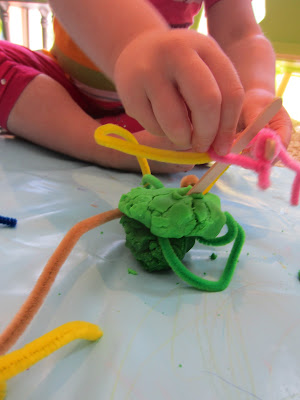Since making our fish we've been excited about making the Underwater Scene for them to live in.
This activity would work best as a follow up or precursor to an excursion to the aquarium or beach, as an activity to complement an interest or in conjunction with a book about fish or the ocean.
Before starting the diorama we researched, using the Internet and books we had about what we might find on the bottom of the ocean.
Here is how we made it:
Here are the materials we used. Cardboard box (we found one that was already blue inside but if you're using a shoebox etc, you might want to paint the inside or cover with cellophane paper etc), rocks (can collect from outside or use river rocks), fishing line (to hand the fish), fish (see how we made them here), PVA glue and brush, things to make coral and seaweed (we used, pipe cleaners, shiny green paper and leaves...you can use whatever you can find around the house), sticks, tape and sand.
- Extend this activity by letting your child attempt some of the more fiddly parts like poking holes where they want their plants and taping fishing wire onto the fish. Ensure that you have talked about and researched the bottom of the ocean so that your child gains a better understanding of what you are doing and why.
- Making things that look visually pleasing as the end result help your child feel proud about what they have created.
- Talk with your child about what they are doing. This will help them understand the physical and mental processes they are going through as well as giving them the vocabulary to describe it.
- Use new language and descriptive words like, "coral" This will help with their language development.
-Ask questions to help connect their understanding and use vocabulary to give them words to describe what they're creating, eg. "How are we going to get the plants to stand up in the bottom of the box?" etc
- Listen to your child talk as they go through their experiences. This will help you determine where they are at with their learning, knowledge and understanding and help you to develop the activity (or future activities) to their level and interests.
-ENJOY spending time with your child :)
Debs :)
Continue reading...
This activity would work best as a follow up or precursor to an excursion to the aquarium or beach, as an activity to complement an interest or in conjunction with a book about fish or the ocean.
Before starting the diorama we researched, using the Internet and books we had about what we might find on the bottom of the ocean.
Here is how we made it:
Here are the materials we used. Cardboard box (we found one that was already blue inside but if you're using a shoebox etc, you might want to paint the inside or cover with cellophane paper etc), rocks (can collect from outside or use river rocks), fishing line (to hand the fish), fish (see how we made them here), PVA glue and brush, things to make coral and seaweed (we used, pipe cleaners, shiny green paper and leaves...you can use whatever you can find around the house), sticks, tape and sand.
Tearing the green shiny paper in strips to make the seaweed. Good fine motor skill practice
Twisting and manipulating the pipe cleaners to make coral and underwater plants
Taping a pipe cleaner to a strip of green paper so that it can be bent into a shape for seaweed
Poke holes in the bottom of your cardboard box for your child to poke their seaweed, coral and plants in
Pouring glue over the bottom of the box. Being careful to avoid the plants
Spread the glue so it covers the entire bottom of the box
Her FAVOURITE part. Sprinkling the sand all over the bottom of the box
Allow the glue to dry and shake off excess sand. Then add your rocks
Almost finished! Time to add the fish. I taped a loop of fishing line to the back of the fish so they could hang over the sticks
Hang the fish on the sticks and then place over the top of the box
The beautiful underwater scene in finished. We had a lot of fun creating this. Hope you do too
Some tips:
- You don't have to use all these same materials. See how we did it and then hunt around your own house for things that would work as well
- Take the time to focus on improving particular skills with your child and help them to practice, ie. Carefully pouring glue so that it goes where intended.
- Extend this activity by letting your child attempt some of the more fiddly parts like poking holes where they want their plants and taping fishing wire onto the fish. Ensure that you have talked about and researched the bottom of the ocean so that your child gains a better understanding of what you are doing and why.
- Making things that look visually pleasing as the end result help your child feel proud about what they have created.
- Use new language and descriptive words like, "coral" This will help with their language development.
-Ask questions to help connect their understanding and use vocabulary to give them words to describe what they're creating, eg. "How are we going to get the plants to stand up in the bottom of the box?" etc
- Listen to your child talk as they go through their experiences. This will help you determine where they are at with their learning, knowledge and understanding and help you to develop the activity (or future activities) to their level and interests.
-ENJOY spending time with your child :)
Debs :)
Look where else we are. Are you following along? :)
New Here? Subscribe to get all activities sent directly to you








































